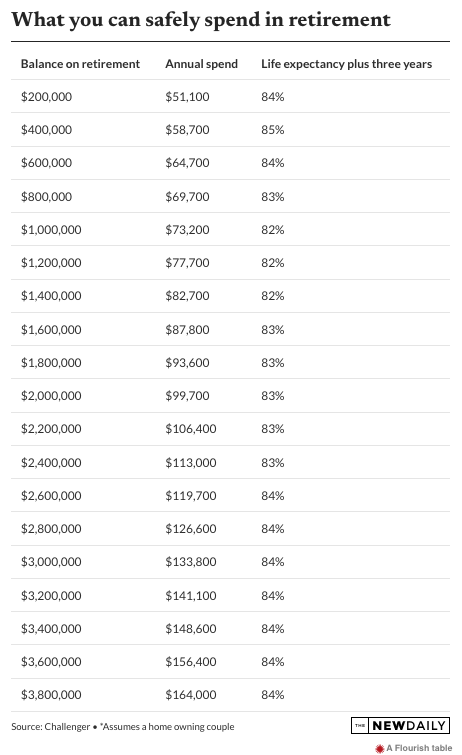How much of my savings should I spend in my retirement years?
Deciding on how much to spend each year in retirement is a pressing question for many people, even before they retire. Here are some answers.

The Association of Superannuation Funds of Australia has a rule-of-thumb calculation that says a home-owning couple aged between 67 and 84 would need an income of $71,723.56 for a comfortable retirement.
Retirement can be a shock after decades of building a retirement balance, because you will be faced with the decision of how you will spend your superannuation.
That sounds like a good problem to have after a lifetime of hard work, but you need to give serious consideration to what you can afford.
“People look at the balance on their statement from their super fund and it’s typically a big number relative to what they earned on an annual basis working,” said Andrew Lowe, technical services chief with investment and annuity group Challenger.
“Converting that balance into an annual figure they can spend over a long period of time is a tough challenge,” Lowe said.
That figure will be determined using several factors including how much you have saved, what your outgoings are, and what your lifestyle desires are.
A comfortable retirement
The Association of Superannuation Funds of Australia has a rule-of-thumb calculation that says a home-owning couple aged between 67 and 84 would need an income of $71,723.56 for a comfortable retirement.
They would need $42,978.78 for a modest retirement.
To deliver that comfortable retirement a couple would need a retirement nest egg of $690,000, and $100,000 for a modest retirement.
Challenger has done a much more detailed analysis of what can be spent in retirement on this table to help in that decision-making.

The table above is quite simple. It assumes a home-owning couple.
The retirement balance represents their joint superannuation balances with no other investments beyond the family home assumed for this exercise.
The annual spend figure is the total amount that can be spent annually to ensure their superannuation has a 90 per cent likelihood of lasting for their expected life span. The final column shows the likelihood of super lasting to life expectancy plus three years.
Given the average life expectancy for a couple is 94 years, that means the calculation is based on super lasting to 97.
The couple are both assumed to be 67 – the age-pension threshold – for working out the calculations.
How long will I live?
The percentage figure is the likelihood of superannuation income lasting to 97.
For example, in the first instance it is assumed there is a 16 per cent chance super will run out before 97.
The table assumes for those with balances below $1.003 million there will be some contribution from the age pension.
A couple with $200,000 in super who spend $51,100 annually would receive $42,988 from the pension and a further $8112 from their superannuation account.
The calculations assume super drawdowns are indexed for inflation, so the lifestyle chosen at retirement will last right through life.
For those comfortable with an 82 to 84 per cent degree of confidence that their super will last a lifetime, holding your super in pension mode should be adequate.
However, for those wanting extra confidence a lifetime pension or annuity product could be used to boost certainty, Lowe says.
As would be expected, higher super balances deliver a much better lifestyle with a fund of just under $1 million needed to deliver the ASFA comfortable retirement income level right through life.
At $1.003 million the age pension is no longer available and also its associated concession card, which “is worth some thousands a year,” Lowe said.
Horses for courses
Of course, you can vary the amount you draw down from your super to match your lifestyle ambitions.
“Often my clients might choose to spend a bit more in, say, the first five years of retirement,” said Antoinette Mullins, principal of Steps Financial.
“You might want to have overseas holidays or buy a camper van and perhaps do some home renovations to make the house more liveable later in life,” Mullins said.
Remember if you spend up in the first years of retirement you will have to cut back a bit for a few years to get back on track with your long-term retirement spending plan.
“But don’t forget that from 70 or 75 onwards, health issues creep in and spending increases. There could even be aged-care costs at some point,” Mullins said.
Challenger has modelled superannuation earnings to grow about 6.25 per cent if invested half each in growth and defensive allocations.
If funds are held in the traditional balanced option of 61 to 80 per cent growth assets, then returns could be even higher with that allocation returning 7.8 per cent annually for the past 15 years.
But it is not wise to be too aggressive in retirement.
“Understand what your yearly income requirements are and make sure there is enough cash in readily accessible deposits or in your super fund to deal with contingencies,” Mullins said.
A cash balance of one, or if you can afford it, two years’ spending is advisable.
“If there is a market hit you don’t have to sell down assets when prices are low,” Mullins said.
A common approach to retirement finance is for people to take from super the minimum mandated drawdown of 5 per cent for those between 65 and 74.
It rises in steps to 14 per cent for those living to 95 or over.
“That looks really weird as an income plan because you begin with low payments and they step up over time,” Lowe said.
Choosing a higher drawdown level within the bounds of Challenger’s tables would lead to a more comfortable retirement, he says.
This column also appears in our sister publication The New Daily, which is owned by Industry Super Holdings.




